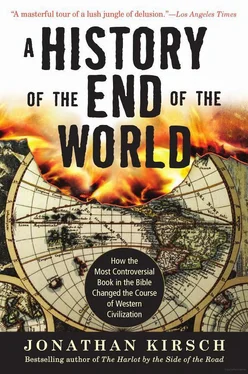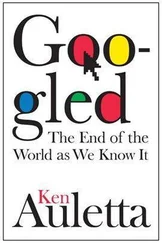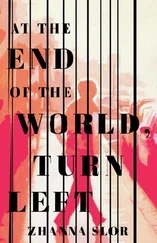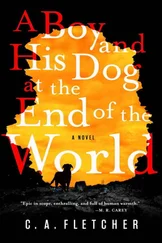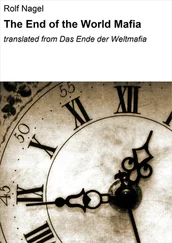“The saints will in no wise have an earthly kingdom, but only a celestial one; thus must cease the fable of one thousand years,” insists Jerome, who characterizes the literal reading of Revelation as a theological error that only a Jew would make. Indeed, that’s the worst accusation and insult that he can lay against any Christian who commits the same error: “To take John’s Apocalypse according to the letter,” he warns, “is to ‘Judaize.’” 104
John’s own ambiguous and highly conflicted attitude toward his Jewish origins will soon disappear under the flood tide of anti-Semitism that washed over Western civilization in the Middle Ages. Future readers will rediscover the theological subtleties at play in Revelation, and they will come to regard themselves as allies and advocates of the Jewish people and even as so-called Christian Zionists. For the next thousand years or so, however, all of the Jews will be consigned to membership in “the synagogue of Satan,” and Revelation will serve to inspire and justify some of the worst atrocities committed against them in the name of “the Lion of the tribe of Judah, the Root of David.” 105
An elaborate mosaic that adorns one medieval church in western Europe reveals something subtle but crucial about the role of Revelation in early Christendom. The oldest portion of the mosaic depicts Jesus seated among the twelve disciples, a scene that was borrowed from the purely pagan motif of a colloquium of philosophers. Later, after Constantine embraced Christianity and the Roman Empire became a Christian empire, the mosaic was embellished with the symbols of imperial authority: the chair on which Jesus sits has been turned into a gem-studded throne, and a golden halo has been added to suggest a kingly crown. And the third and final overlay introduces elements from the distinctive iconography of the book of Revelation—the “four living creatures” who serve God in the divine throne room; the celestial city of Jerusalem; and the Lamb of God, looking as if he were slain and yet standing upright with a sword in his mouth. 106
By deconstructing the mosaic, scholars have confirmed a curious fact about the book of Revelation. The images of the Apocalypse were used only rarely in Christian art and architecture prior to the fourth century. Then, abruptly, the sword-wielding Lamb of God and other iconic symbols of the end-times begin to appear on sarcophagi, ivory carvings, murals, mosaics, and monumental paintings throughout Christendom. Alpha and omega, the Greek letters that John uses to evoke the creation and destruction of the world, are inscribed on artifacts ranging from a woman’s gold ring to a slave collar. So “sudden and profuse” was the eruption of apocalyptic imagery in Christian arts and crafts that one scholar characterizes the phenomenon as an “invasion”: the Apocalypse seemed to suddenly seize the imagination of both clergy and laity throughout Christendom, and the vengeful Christ of Revelation displaced the suffering Christ of the Gospels. 107
The apocalyptic invasion was especially lively and long-enduring in western Europe. But the same phenomenon can be seen in eastern Christendom, where Revelation was received only belatedly and only with a certain trepidation. Thus, for example, a strange text titled The Revelation of the Holy Theologian John, which first appeared in the eastern Roman Empire as early as the fifth century, depicts a heavenly encounter between God and the author of Revelation in which the physical features of the satanic “beast” are described in detail: “The appearance of his face is gloomy; his hair is like the points of arrows; his brows rough; his right eye as the rising morning star and the left like a lion’s,” John is told. “His mouth is a cubit wide, his teeth a span in length, his fingers are like sickles. His footprints are two cubits long, and on his forehead is the writing, ‘The Antichrist.’” 108
The timing of the apocalyptic invasion is highly revealing. John may have intended the book of Revelation to console and exhort the persecuted Christians of his own era, but it was only when Christianity was both militant and triumphant that the imagery of the Apocalypse began to proliferate across Europe. Indeed, Revelation achieved its sudden and widespread prominence shortly after Emperor Theodosius formally raised Christianity to the status of the state religion of the Roman Empire in 391.
The apocalyptic invasion also coincides with a powerful change in the Christian perception of the world. The machinery of Roman power that had once been used against the Christians—the constabulary, the courts, the torture chambers, and the execution blocks—were now available to Christian authorities for use against their own enemies both inside and outside the church. So the Christ who is depicted in the Gospels as the victim of torture and execution suddenly seemed less appropriate to the new circumstances of the church than the Christ of Revelation who rides a warhorse, wields a sword, and wears a crown.
At the same time, of course, the Roman Empire was already in decline and fast approaching its ultimate fall. Rome itself and the western reaches of the empire disintegrated into a chaotic assortment of “barbarian” kingdoms soon after the sack of Rome in 410, and the eastern remnant was continually menaced by the pagan armies of Persia. Bubonic plague—the dreaded Black Death that seems to be prefigured in the imagery of Revelation—first appeared in the sixth century and reached epidemic proportions over the next two hundred years. By the eighth century, former Roman provinces in Spain, North Africa, and the Levant, including the city of Jerusalem itself, had fallen under the banner of militant Islam.
Revelation, however, offered a way to understand even the most catastrophic events as an augury of a greater triumph. Theologians may have debated whether the thousand-year reign of Christ as depicted in Revelation is prophecy or allegory, but whether Revelation is read “carnally” or “spiritually,” its unambiguous message is that, sooner or later, the world will be destroyed once and for all, and any Christian soul who is judged worthy by Jesus Christ will live forever in a celestial kingdom. Even Augustine, who declined to take the book of Revelation too literally, was convinced that the end of the world was inevitable.
“Elijah shall come; the Jews shall believe; Antichrist shall persecute; Christ shall judge; the dead shall rise; the good and the wicked shall be separated; the world shall be burned and renewed,” Augustine concedes. “All these things, we believe, shall come to pass; but how, or in what order, human understanding cannot perfectly teach us, but only the experience of the events themselves.” 109
Augustine’s pointed phrase—“the experience of the events themselves”—reminds us of exactly what prompted a great many otherwise pious Christians to ignore his cautions about reading the book of Revelation as literal truth. For nearly a thousand years, daily life in the here and now seemed to fulfill even the most frightful prophecies of Revelation, and the end of the world seemed to be very near indeed. And yet, on the far side of their tribulation—wars and rumors of war, famine and plague, and all the other biblical afflictions that God promises to bring down on a suffering humanity—the readers of Revelation glimpsed the tantalizing sight of a new heaven, a new earth, and a New Jerusalem whose streets were paved with gold.
For all of the high anxiety and Grand Guignol on display in its pages, in fact, Revelation has always been understood by some readers as a story with the happiest of endings. That’s why Revelation can be a soporific drug—“Take it, and eat it up,” says an angel to John, urging him to literally consume the “little book”—that leaves the reader in a kind of mystical stupor. 110Since God’s plan for the world is already written down in the pages of Holy Writ—and since God has promised to raise the saints and martyrs to eternal life in the end-times—the credulous readers of Revelation are content to close their eyes to the dangerous world in which they live, dream of the delights to come in the messianic kingdom, and pray that they will wake up in the celestial Jerusalem.
Читать дальше
